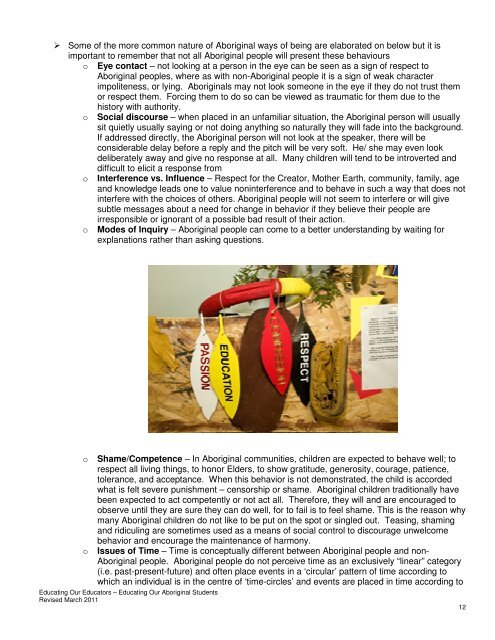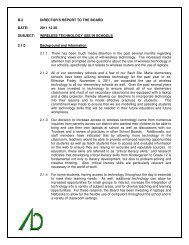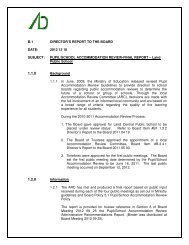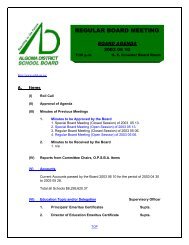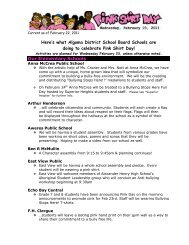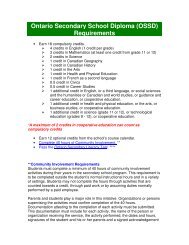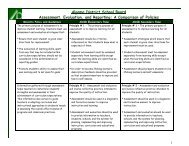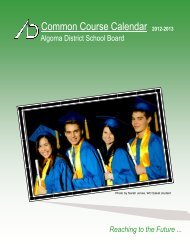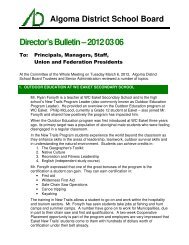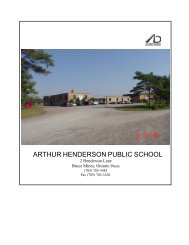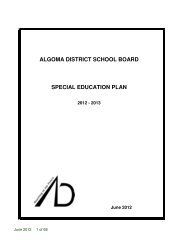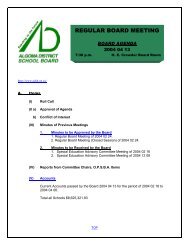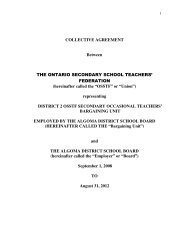Educating Our Educators (March 2011) - Algoma District School Board
Educating Our Educators (March 2011) - Algoma District School Board
Educating Our Educators (March 2011) - Algoma District School Board
- No tags were found...
You also want an ePaper? Increase the reach of your titles
YUMPU automatically turns print PDFs into web optimized ePapers that Google loves.
Some of the more common nature of Aboriginal ways of being are elaborated on below but it isimportant to remember that not all Aboriginal people will present these behaviourso Eye contact – not looking at a person in the eye can be seen as a sign of respect toAboriginal peoples, where as with non-Aboriginal people it is a sign of weak characterimpoliteness, or lying. Aboriginals may not look someone in the eye if they do not trust themor respect them. Forcing them to do so can be viewed as traumatic for them due to thehistory with authority.o Social discourse – when placed in an unfamiliar situation, the Aboriginal person will usuallysit quietly usually saying or not doing anything so naturally they will fade into the background.If addressed directly, the Aboriginal person will not look at the speaker, there will beconsiderable delay before a reply and the pitch will be very soft. He/ she may even lookdeliberately away and give no response at all. Many children will tend to be introverted anddifficult to elicit a response fromo Interference vs. Influence – Respect for the Creator, Mother Earth, community, family, ageand knowledge leads one to value noninterference and to behave in such a way that does notinterfere with the choices of others. Aboriginal people will not seem to interfere or will givesubtle messages about a need for change in behavior if they believe their people areirresponsible or ignorant of a possible bad result of their action.o Modes of Inquiry – Aboriginal people can come to a better understanding by waiting forexplanations rather than asking questions.o Shame/Competence – In Aboriginal communities, children are expected to behave well; torespect all living things, to honor Elders, to show gratitude, generosity, courage, patience,tolerance, and acceptance. When this behavior is not demonstrated, the child is accordedwhat is felt severe punishment – censorship or shame. Aboriginal children traditionally havebeen expected to act competently or not act all. Therefore, they will and are encouraged toobserve until they are sure they can do well, for to fail is to feel shame. This is the reason whymany Aboriginal children do not like to be put on the spot or singled out. Teasing, shamingand ridiculing are sometimes used as a means of social control to discourage unwelcomebehavior and encourage the maintenance of harmony.o Issues of Time – Time is conceptually different between Aboriginal people and non-Aboriginal people. Aboriginal people do not perceive time as an exclusively “linear” category(i.e. past-present-future) and often place events in a ‘circular’ pattern of time according towhich an individual is in the centre of ‘time-circles’ and events are placed in time according to<strong>Educating</strong> <strong>Our</strong> <strong>Educators</strong> – <strong>Educating</strong> <strong>Our</strong> Aboriginal StudentsRevised <strong>March</strong> <strong>2011</strong>12


